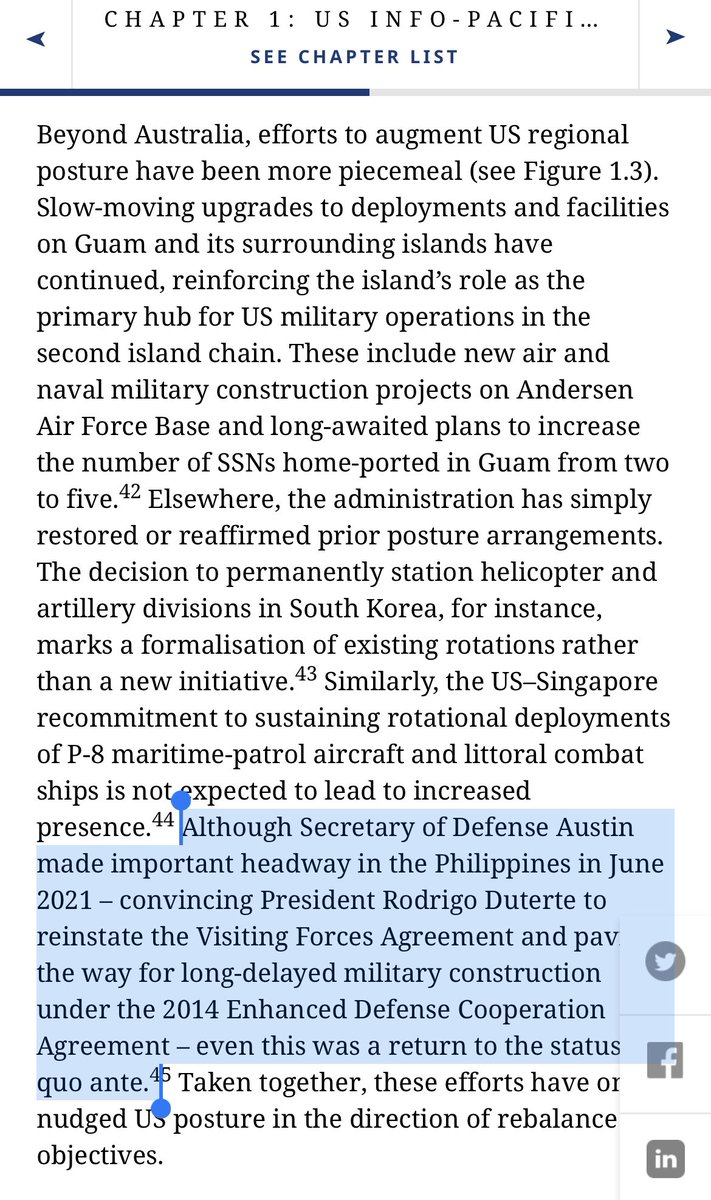I’m pleased to share my new @IISS_org analysis with @jamescrabtree on the state of US defence strategy, alliances and partners in the Indo-Pacific, launched at #SLD22.
It’s a sobering read. A🧵on why we’re so worried about the trajectory of US strategy. 1/iiss.org/publications/s…
It’s a sobering read. A🧵on why we’re so worried about the trajectory of US strategy. 1/iiss.org/publications/s…
Some good news first: the Biden admin recognises the Indo-Pacific should be its top priority and China its pacing challenge.
It realises the US can’t uphold a favourable balance of power vs China by itself (see graph) and its trying to advance a strategy of collective defence 2/
It realises the US can’t uphold a favourable balance of power vs China by itself (see graph) and its trying to advance a strategy of collective defence 2/

But the US has not matched its Indo-Pacific rhetoric w the actions and resources needed to bolster its strategic position
Despite some progress, the Biden admin is lagging on the three key elements of US defence strategy in the region: prioritisation, posture and partnerships 3/
Despite some progress, the Biden admin is lagging on the three key elements of US defence strategy in the region: prioritisation, posture and partnerships 3/

On prioritisation: Biden did well to extract the US from Afghanistan and avoid direct conflict w Russia over Ukraine.
But this hasn’t advanced a pivot to Asia. The are still 47,000 troops in the Middle East. And Ukraine has become a major drain on attention and resources. 4/
But this hasn’t advanced a pivot to Asia. The are still 47,000 troops in the Middle East. And Ukraine has become a major drain on attention and resources. 4/

A big US focus on Europe and ME would be OK if: a) Asia was also getting defence resources en masse, and b) DoD’s budget was rising.
But this isn’t the case. It’s a fight to get tailored defence funds for Asia. And DoD is falling well short of its 2018 3-5% real growth target 5/
But this isn’t the case. It’s a fight to get tailored defence funds for Asia. And DoD is falling well short of its 2018 3-5% real growth target 5/

On posture: while China’s military buildup is making rapid advances, US Indo-Pacific posture is only inching along
Projects on Guam/Australia are good but insufficient. The Pacific Deterrence Initiative needs more funds/focus. Biden’s posture review made no decisive shifts. 6/

Projects on Guam/Australia are good but insufficient. The Pacific Deterrence Initiative needs more funds/focus. Biden’s posture review made no decisive shifts. 6/


Posture takes time and what’s needed now — ie a more resilient and distributed set of operating locations — should have started 10yrs ago.
Friction w allies has caused some setbacks. But disagreement on military strategy and spending inside US is arguably the bigger obstacle. 7/
Friction w allies has caused some setbacks. But disagreement on military strategy and spending inside US is arguably the bigger obstacle. 7/

On partnerships: while the Biden team has emphasised the need to work w allies to share more of the collective defence burden, its not yet doing enough to empower them.
The pace of defence industrial cooperation between the US and Australia, Japan, ROK, India bears this out 8/

The pace of defence industrial cooperation between the US and Australia, Japan, ROK, India bears this out 8/


Long-standing obstacles like US export controls, restrictions on tech transfer, Buy American rules and intel-sharing barriers all need reform if the US is to successfully bolster the high-end deterrence capabilities of key Asian partners.
Even AUKUS — Biden’s flagship… 9/
Even AUKUS — Biden’s flagship… 9/

…alliance initiative — will need such reforms to succeed.
Much has been done (ie Quad) to advance a collective policy agenda. But as US can’t deter China alone, it must do more to help allies help themselves — ie by building own strike capabilities, industrial bases etc 10/
Much has been done (ie Quad) to advance a collective policy agenda. But as US can’t deter China alone, it must do more to help allies help themselves — ie by building own strike capabilities, industrial bases etc 10/

So where does this leave US Indo-Pacific defence strategy?
After yrs of neglect, the US is doing more to strengthen priorities, posture and p’ships in the region. But efforts aren’t keeping up w the deteriorating strategic landscape. Collectively we must do better, and fast. 11/
After yrs of neglect, the US is doing more to strengthen priorities, posture and p’ships in the region. But efforts aren’t keeping up w the deteriorating strategic landscape. Collectively we must do better, and fast. 11/

Our sincere thanks to @CorbenTom and Alice Nason for their research assistance, and to the @IISS_org team who produces this outstanding volume, esp @LynnKuok and @DrTimHuxley.
Check out all the other excellent contributions in the #SLD22 APRSA here 12/12: iiss.org/publications/s…
Check out all the other excellent contributions in the #SLD22 APRSA here 12/12: iiss.org/publications/s…
• • •
Missing some Tweet in this thread? You can try to
force a refresh
















